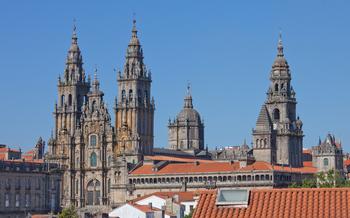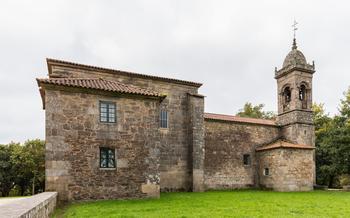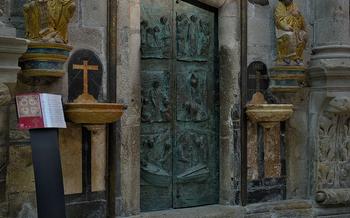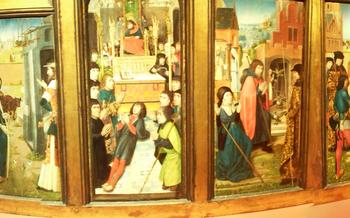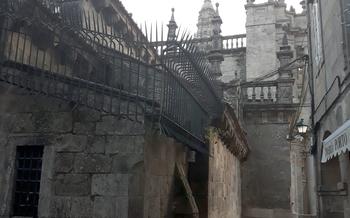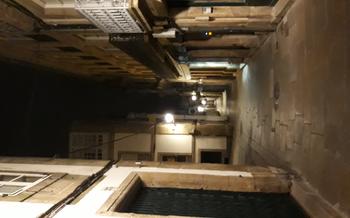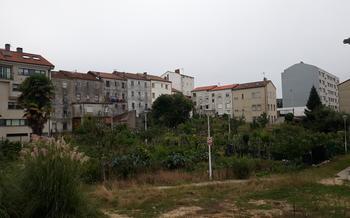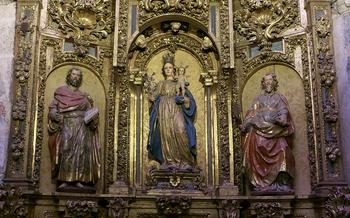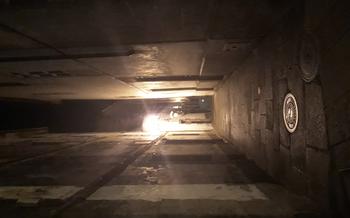
Iglesia de San Pedro Church with Romanesque origins
- Iglesia de San Pedro: A Romanesque Masterpiece
- Architectural Features of the Romanesque Style
- Highlights of the Church's Interior
- Practical Information for Visitors
- Exploring the Plaza de Platerías
- Pilgrimage Significance of the Church
- Interactive Pilgrim Museum
- Other Notable Romanesque Churches in Santiago
- The Legend of the Rooster and the Hen
- Hidden Architectural Details
- A Spiritual Retreat
- Tracing the History of the Church
- Local Festivals and Celebrations
- Tips for Photography Enthusiasts
- Exploring the Neighborhood
- The Church's Role in the Community
- Preservation and Restoration Efforts
- Insider Tip: Hidden Rooftop View
Iglesia de San Pedro: A Romanesque Masterpiece
Nestled in the the enduring legacy of Romanesque architecture. Its origins can be traced back to the 12th century, when it was built as a Benedictine monastery. Over the centuries, the church has undergone several renovations and additions, blending elements of Romanesque, Gothic, and Renaissance styles.
The exterior of the church is characterized by its sturdy stone construction, featuring intricate carvings and decorative elements. The most striking feature is the elaborate main portal, adorned with sculptures depicting scenes from the Bible and the life of Jesus Christ. The interior is equally impressive, with a spacious nave, elegant ribbed vaults, and a stunning apse adorned with beautifully preserved frescoes. These frescoes, dating back to the 14th century, depict scenes from the life of Saint Peter, the patron saint of the church.
Architectural Features of the Romanesque Style
The Iglesia de San Pedro exemplifies the distinctive features of the Romanesque architectural style. Its thick stone walls, rounded arches, and groin vaults create a sense of solidity and strength. The use of massive piers and columns supports the heavy stonework, while the barrel-vaulted ceiling adds to the church's grandeur.
The exterior of the church is further adorned with elaborate carvings and sculptures. The main portal, with its intricate relief work, is a masterpiece of Romanesque art. The tympanum, the triangular space above the lintel, features a sculpture of Christ in Majesty, surrounded by the symbols of the four evangelists. The archivolts, the concentric bands of decoration around the arch, are adorned with carved figures of saints, prophets, and mythical creatures.
Highlights of the Church's Interior
The interior of the Iglesia de San Pedro is equally impressive, with a spacious nave, elegant ribbed vaults, and a stunning apse. The nave is lined with massive piers and columns, which support the weight of the vaulted ceiling. The groin vaults, created by the intersection of two barrel vaults, add to the church's sense of height and grandeur.
The apse, the semi-circular sanctuary at the east end of the church, is the focal point of the interior. It is adorned with beautifully preserved frescoes, dating back to the 14th century. These frescoes depict scenes from the life of Saint Peter, the patron saint of the church. The apse also features a Romanesque altarpiece, with intricately carved figures and a central panel depicting the crucifixion of Jesus Christ.
Practical Information for Visitors
The Iglesia de San Pedro is open to the public daily from 9am to 1pm and 4pm to 7pm. Admission is free of charge. Visitors are advised to dress respectfully, as the church is a place of worship.
Guided tours of the church are available upon request, providing visitors with an in-depth understanding of its history, architecture, and significance. The church is also a popular destination for pilgrims on the Camino de Santiago, who often visit to receive a Compostela certificate, a document that certifies their completion of the pilgrimage.
Whether you are a history buff, an architecture enthusiast, or a pilgrim seeking spiritual fulfillment, the Iglesia de San Pedro is a must-visit destination in Santiago de Compostela. Its Romanesque grandeur, stunning frescoes, and rich history make it a captivating and awe-inspiring place to explore.
Exploring the Plaza de Platerías
The Plaza de Platerías, both locals and visitors. The square's name, translating to "Silversmiths' Square," reflects its historical significance as a hub for silversmiths and jewelers.
The surrounding buildings showcase a captivating blend of architectural styles, seamlessly transitioning from Romanesque to Gothic and Renaissance. Admire the intricate details of the Casa del Cabildo, featuring a beautiful Renaissance facade, and the Pazo de Raxoi, the current seat of the Galician government, which boasts a Gothic tower.
The Plaza de Platerías forms an integral part of the pilgrimage route, leading directly to the Cathedral of Santiago de Compostela. Pilgrims traditionally gather here before entering the cathedral, seeking guidance and inspiration for the final leg of their journey.
As you explore the square, keep an eye out for unique souvenirs and local delicacies. Browse the stalls selling traditional Galician crafts, including intricate silver jewelry and pottery, or indulge in the region's culinary delights, such as fresh seafood and the famous Galician octopus.
Pilgrimage Significance of the Church
The Iglesia de San Pedro holds a significant role in the Camino de Santiago, a renowned pilgrimage route that attracts millions of people each year. For centuries, pilgrims have flocked to Santiago de Compostela, the final destination of the Camino, to seek spiritual fulfillment and pay homage to the remains of Saint James the Great.
The church serves as a pivotal stop along the pilgrimage route, where pilgrims can seek solace, receive spiritual guidance, and obtain a Compostela certificate, a document that acknowledges their successful completion of the Camino. The Compostela certificate is highly prized among pilgrims, serving as a tangible testament to their arduous journey and spiritual transformation.
Pilgrims often arrive at the church weary and footsore, but are greeted with open arms by the local community and fellow pilgrims. The church provides a sanctuary for pilgrims to rest, pray, and reflect on their experiences along the Camino. The atmosphere is one of camaraderie and shared purpose, as pilgrims from all walks of life come together to celebrate their journey and pay homage to Saint James.
The scallop shell, a symbol of the Camino de Santiago, is prominently displayed throughout the church, serving as a reminder of the pilgrimage's spiritual significance. Pilgrims often carry scallop shells with them as a symbol of their journey, and the church's collection of shells from pilgrims around the world is a testament to the enduring legacy of the Camino.
Interactive Pilgrim Museum
Housed within the walls of the Iglesia de San Pedro, the Interactive Pilgrim Museum offers an immersive journey into the history, culture, and traditions of the Camino de Santiago. Through engaging exhibits, hands-on activities, and interactive displays, visitors can explore the significance of the pilgrimage route and the experiences of pilgrims throughout the centuries.
The museum's exhibits showcase a diverse collection of artifacts, including replicas of medieval pilgrim clothing, maps charting the different routes of the Camino, and multimedia presentations depicting the challenges and rewards of the pilgrimage. Visitors can learn about the rituals and customs associated with the Camino, such as the tradition of receiving a Compostela certificate upon reaching Santiago de Compostela.
Interactive displays allow visitors to experience the pilgrimage firsthand. They can simulate the weight of a pilgrim's backpack, try on replica clothing and footwear, and even engage in virtual reality experiences that transport them to different stages of the Camino. The museum also features a replica of a medieval pilgrim's hostel, providing a glimpse into the communal living arrangements of pilgrims in the past.
A visit to the Interactive Pilgrim Museum is a must for anyone interested in the Camino de Santiago. It offers a unique opportunity to learn about the history, culture, and spirituality of this ancient pilgrimage route and to gain a deeper appreciation for the experiences of pilgrims who have undertaken the journey.
Other Notable Romanesque Churches in Santiago
Santiago de Compostela is a treasure trove of Romanesque architecture, with several other churches worth exploring beyond the Iglesia de San Pedro. Each church possesses unique features and historical significance, contributing to the city's rich cultural heritage.
-
Iglesia de Santa María Salomé: Located near the Plaza del Obradoiro, this church is renowned for its intricately carved facade depicting scenes from the Bible.
-
Iglesia de Santo Domingo de Bonaval: Situated on the banks of the Sarela River, this former Dominican monastery boasts a beautiful Romanesque cloister adorned with delicate arches and columns.
-
Iglesia de San Fructuoso de Montesacro: Nestled on a hilltop overlooking the city, this church offers stunning panoramic views and features a well-preserved Romanesque apse.
-
Iglesia de San Martín Pinario: Once a Benedictine monastery, this church showcases a mix of Romanesque and Baroque styles, with a magnificent altarpiece and impressive vaulted ceilings.
-
Iglesia de Santiago Apostol: Located in the heart of the city's old town, this church is dedicated to Saint James the Apostle and is believed to be built on the site of his tomb.
These churches provide an opportunity to delve deeper into the Romanesque architectural heritage of Santiago de Compostela, offering a journey through history and artistry. Consider creating a self-guided Romanesque church tour to explore these hidden gems and discover the unique stories they hold.
The Legend of the Rooster and the Hen
Amidst the intricate carvings and sculptures adorning the facade of the Iglesia de San Pedro, two peculiar figures stand out: a rooster and a hen. These seemingly inconspicuous creatures hold a special place in the folklore and symbolism of Santiago de Compostela.
According to legend, a pilgrim once arrived in Santiago exhausted and penniless. Desperate for food, he knocked on the door of a local farmer, seeking sustenance. The farmer's wife, moved by the pilgrim's plight, offered him a meager meal of bread and cheese.
As the pilgrim sat down to eat, a rooster and a hen, perched on a nearby beam, watched him intently. The rooster, overcome with pity, turned to the hen and said, "We must help this poor pilgrim. He has a long journey ahead of him."
The hen, equally compassionate, replied, "But what can we do? We have nothing to give."
The rooster, undeterred, responded, "We can give him our lives."
With that, the rooster and the hen jumped down from the beam and offered themselves to the pilgrim as food. The pilgrim, taken aback by their generosity, initially refused, but the rooster and the hen insisted.
Moved by their sacrifice, the pilgrim accepted their gift and ate them. The rooster and the hen's sacrifice gave the pilgrim the strength he needed to complete his journey to Santiago de Compostela.
In recognition of their selfless act, the rooster and the hen were immortalized in stone on the facade of the Iglesia de San Pedro, a lasting tribute to their compassion and generosity.
To this day, pilgrims and visitors alike seek out these sculptures, paying homage to the legendary rooster and hen and reflecting on the profound symbolism they represent.
Hidden Architectural Details
A keen eye will uncover a treasure trove of hidden symbols and carvings adorning the exterior of the Iglesia de San Pedro. These intricate details, often overlooked by casual visitors, reveal the rich history and symbolism embedded within the church's architecture. From the enigmatic carvings of animals and mythical creatures to the subtle geometric patterns, each element holds a deeper meaning.
The church's facade is a canvas for these hidden treasures. Look closely at the capitals atop the columns, where intricate scenes from biblical stories and everyday life unfold in miniature. Each capital tells a unique tale, from the Annunciation to the Last Supper, offering a glimpse into the minds of the medieval artisans who crafted them.
The doorways are another treasure trove of hidden details. The archivolts, or decorative bands around the arches, are adorned with intricate carvings of plants, animals, and human figures. These carvings often have symbolic meanings, representing virtues, vices, or celestial bodies.
Don't miss the corbels, the small brackets supporting the eaves of the roof. These often feature whimsical carvings of animals, human heads, or mythical creatures, adding a touch of playfulness to the church's otherwise solemn exterior.
Discovering these hidden architectural details is like embarking on a treasure hunt. Each discovery unveils another layer of the church's history and symbolism, inviting visitors to delve deeper into its rich tapestry.
A Spiritual Retreat
Amidst the bustling streets of Santiago de Compostela, the Iglesia de San Pedro stands as an oasis of tranquility. Its serene atmosphere invites pilgrims and visitors alike to pause, reflect, and connect with their inner spirituality. As you step inside the hallowed halls of this ancient church, a sense of peace envelops you, enveloping you in a warm embrace.
The soft glow of candlelight illuminates the intricate carvings and frescoes that adorn the walls, casting a mystical aura upon the sacred space. The air is filled with the gentle murmur of prayers and the faint scent of incense, creating an atmosphere conducive to contemplation and devotion.
Whether you are a devout pilgrim seeking solace or a curious traveler searching for a deeper connection, the Iglesia de San Pedro offers a sanctuary for the soul. Here, you can escape the distractions of the outside world and immerse yourself in the tranquility of this sacred space.
In the quiet corners of the church, you can kneel in prayer, offering your hopes and dreams to the divine. The flickering flames of the candles will guide your thoughts and intentions, helping you to connect with a higher power. As you sit in silent contemplation, let the beauty of the surroundings inspire you to reflect on your life's journey and find inner peace.
The Iglesia de San Pedro is not just a historical monument; it is a living testament to the power of faith and spirituality. Within its walls, countless pilgrims have found solace, guidance, and strength to continue their journey along the Camino de Santiago. Whether you are a believer or not, the church's sacred atmosphere will touch your soul and leave you with a sense of peace and serenity.
Tracing the History of the Church
The story of Iglesia de San Pedro is one of transformation and adaptation, reflecting the evolving architectural styles and historical events that have shaped Santiago de Compostela. Originally constructed in the 12th century, the church showcased the distinctive features of Romanesque architecture, including its sturdy stone construction, rounded arches, and intricate carvings.
Over the centuries, the church underwent several modifications and expansions, influenced by subsequent architectural movements. In the 16th century, Gothic elements were incorporated, adding delicate ornamentation and taller, pointed arches to the structure. The Baroque period brought further embellishments, such as the elaborate altarpiece and the ornate facade.
These architectural changes mirror the historical significance of Iglesia de San Pedro, which has witnessed countless events that shaped the city's identity. It served as a gathering place for pilgrims embarking on the Camino de Santiago, a spiritual journey that has left an enduring mark on the region. The church's history is intertwined with that of the city, embodying Santiago de Compostela's rich cultural and religious heritage.
Local Festivals and Celebrations
Throughout the year, the Iglesia de San Pedro and its surrounding neighborhood come alive with a variety of local festivals and celebrations that showcase the rich cultural heritage of Santiago de Compostela. These events offer a vibrant glimpse into the city's traditions and provide an opportunity to experience the infectious energy of the local community.
One of the most notable celebrations is the Feast of San Pedro, held annually on June 29th. This festival honors the patron saint of the church and features a colorful procession, traditional Galician music and dancing, and a lively street fair filled with local delicacies and handmade crafts.
Another popular event is the Santiago Apóstol Festival, which takes place on July 25th. This grand festival is a celebration of the city's patron saint, Saint James the Apostle. The festivities include solemn religious ceremonies, vibrant parades featuring traditional costumes and floats, and a spectacular fireworks display that illuminates the night sky.
During the Christmas season, the church and its surroundings are adorned with festive decorations, creating a magical and enchanting atmosphere. The neighborhood comes together to celebrate with traditional Christmas markets, carol singing, and heartwarming nativity scenes that depict the birth of Jesus.
These festivals and celebrations are not merely spectacles for tourists but genuine expressions of the local culture and a testament to the deep-rooted traditions of Santiago de Compostela. By immersing yourself in these events, you'll gain a deeper appreciation for the city's heritage and forge lasting memories that will stay with you long after your visit.
Tips for Photography Enthusiasts
The Iglesia de San Pedro is a photographer's paradise, offering endless opportunities to capture stunning images. With its intricate carvings, unique architectural features, and picturesque surroundings, the church provides a wealth of subjects to explore and photograph.
For the best results, arrive early in the morning or late in the afternoon to take advantage of the warm, golden light. The church's west-facing facade is particularly beautiful at sunset, when the soft light illuminates the intricate details of the stonework.
Don't be afraid to experiment with different angles and perspectives. The church's narrow streets and hidden corners provide ample opportunities for creative compositions. Try shooting from a low angle to emphasize the grandeur of the building, or capture the interplay of light and shadow as it filters through the church's stained-glass windows.
To truly capture the essence of the church, take some time to explore the interior as well. The dim, atmospheric lighting creates a sense of mystery and awe, highlighting the intricate frescoes and carvings that adorn the walls and ceilings. Use a tripod to steady your camera and capture long exposures to capture the full beauty of the interior.
Once you have captured your shots, be sure to share them with the world! Post your photos on social media, submit them to photography competitions, or even create a blog or website dedicated to your travels. Your images can help to promote the beauty of this hidden gem and inspire others to visit and experience its magic for themselves.
Exploring the Neighborhood
The neighborhood surrounding the Iglesia de San Pedro is a treasure trove of hidden gems, waiting to be explored. Just steps away from the church, you'll find a labyrinth of narrow cobblestone streets, lined with charming boutiques, inviting cafés, and traditional restaurants.
Take some time to wander through these picturesque streets, browsing the unique shops for local handicrafts, souvenirs, and culinary delights. Stop for a bite to eat at a traditional Galician restaurant, savoring the flavors of the region's fresh seafood and hearty stews.
Be sure to visit the nearby Plaza de Abastos, a bustling market where you can immerse yourself in the sights, sounds, and aromas of local produce, fresh fish, and artisanal cheeses. This vibrant market is a testament to the region's rich culinary traditions and offers a glimpse into the daily lives of the locals.
As you explore the neighborhood, pay attention to the architectural details of the surrounding buildings. Many of these structures date back centuries and showcase a blend of Romanesque, Gothic, and Renaissance styles. Admire the intricate carvings, ornate balconies, and colorful facades that adorn these historic buildings.
Take advantage of your time in the neighborhood to visit other notable landmarks, such as the Museo de Arte Sacra, which houses a collection of religious art and artifacts from the region. Or, stroll along the banks of the Río Sar, enjoying the tranquil atmosphere and picturesque views.
Whether you're seeking unique souvenirs, delicious cuisine, or simply a chance to soak in the local atmosphere, the neighborhood surrounding the Iglesia de San Pedro offers a wealth of experiences for the curious traveler.
The Church's Role in the Community
The Iglesia de San Pedro plays a vital role in the community of Santiago de Compostela. It serves as a gathering place for locals, offering a sense of belonging and togetherness. The church is actively involved in various charitable initiatives and community outreach programs, extending its support to those in need. Whether it's providing assistance to the underprivileged, organizing events that foster social cohesion, or simply offering a listening ear, the church strives to make a positive impact on the lives of its parishioners and the wider community.
One notable example of the church's commitment to social welfare is its collaboration with local organizations to provide food and shelter to the homeless population. The church also hosts regular fundraisers and charity events to support various causes, demonstrating its dedication to giving back to the community.
Furthermore, the church serves as a hub for cultural and educational activities. It organizes lectures, workshops, and exhibitions that promote local history, art, and traditions. These events provide opportunities for people to learn, connect, and celebrate their shared heritage.
Through its unwavering commitment to community service, the Iglesia de San Pedro has become an integral part of the fabric of Santiago de Compostela. It stands as a beacon of hope, support, and unity, enriching the lives of its members and contributing to the overall well-being of the city.
Preservation and Restoration Efforts
The Iglesia de San Pedro, with its rich history and architectural significance, requires ongoing preservation and restoration efforts to maintain its grandeur for future generations. The passage of time, environmental factors, and natural wear and tear have taken their toll on the centuries-old structure.
Preserving the church's original features and preventing further deterioration is a top priority for local authorities and heritage organizations. Regular inspections and assessments are conducted to identify areas that need attention, such as structural reinforcements, stonework repairs, and restoration of frescoes and paintings.
One of the key challenges in preserving the church is balancing the need for conservation with the desire to retain its historical authenticity. The goal is to preserve the original character and integrity of the building while using appropriate materials and techniques that respect its heritage.
Visitors can contribute to the preservation efforts by being mindful of their actions within the church. Touching or leaning against fragile surfaces, using flash photography, and bringing food or drinks inside the church should be avoided. Donations and support for local preservation initiatives are also greatly appreciated.
By working together, the community, authorities, and visitors can ensure that the Iglesia de San Pedro continues to stand as a testament to the city's rich history and architectural prowess for generations to come.
Insider Tip: Hidden Rooftop View
For those seeking an unforgettable experience, venture to the church's rooftop for a breathtaking panorama of Santiago de Compostela. While this hidden gem is not officially open to the public, persistent travelers might find a way to access it. The best time to visit is early in the morning or late in the afternoon, when the golden light casts a magical glow over the city. From this unique vantage point, you'll witness the intricate details of the church's architecture up close, while the cityscape unfolds before you like a living tapestry. Capture the essence of this moment with your camera, creating lasting memories of your pilgrimage or exploration of Santiago de Compostela.
